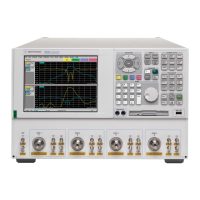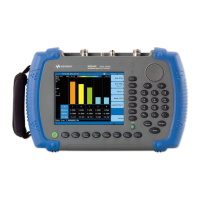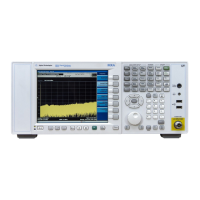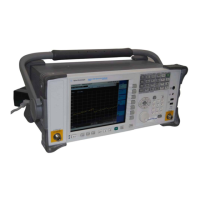Service Guide N5230-90014 5-19
PNA Series Microwave Network Analyzers Theory of Operation
N5230A Receiver Group Operation
Receiver Group Operation
The receiver group measures and processes the input signals into digital information for
processing and eventual display. Figure 5-6 on page 5-20 is a simplified block diagram of
the receiver functional group.
In this section the following assemblies are described:
• A20 Mixer Brick
• A5 SPAM Board (Analog Description)
A20 Mixer Brick
This assembly contains four identical amplifiers, mixers, and filters. With the spur
avoidance function OFF, the test signals (channels A and B) and the reference signals
(channels R1 and R2) are mixed with a synthesized source signal that is 7.66 MHz higher
than the source incident signal to produce a 7.66 MHz IF signal.
With the spur avoidance function ON, at frequencies below 40 MHz, the IF is set to various
values between 1 and 12 MHz to avoid spurious responses that could interfere with the
measurement. Because of this, the spur avoidance function should be OFF when
troubleshooting the PNA-L.
The analog IF signal is sent to the A5 SPAM board where it is converted to digital
information.
A5 SPAM Board (Analog Description)
The A5 SPAM board contains digital and analog circuitry. For digital descriptions, refer to
“A5 SPAM Board (Digital Description)” on page 5-24.
In this assembly, the IF signals from the A, B, R1, and R2 mixers go through a gain stage
where small signals are amplified to ensure that they can be detected by the
analog-to-digital converter (ADC).
All four signals are sampled simultaneously by the ADCs, where they are converted to
digital form. The ADC conversions are triggered by timing signals from the digital signal
processor (DSP) in response to commands from the central processing unit (CPU). The
digitized data is processed into magnitude and phase data by the DSP and sent to the CPU
random access memory (RAM) by way of the peripheral component interconnect (PCI) bus.
The processed and formatted data is finally routed to the display, and to the
general-purpose interface bus (GPIB) for remote operation. Refer to “Digital Processing
and Digital Control Group Operation” on page 5-21 for more information on signal
processing.

